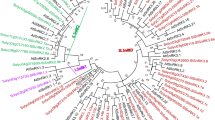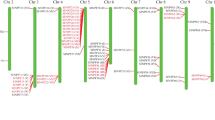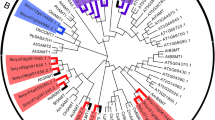Abstract
Phylogenetic analysis based on the deduced amino acid sequence of phenylalanine ammonia-lyase gene (SlPAL5) cDNA from tomato (Solanum lycopersicum L.) revealed high sequence similarity to PAL genes in Nicotiana tabacum (92%), Ipomoea nil (87%), Manihot esculenta (84%), and Catharanthus roseus (84%). The SlPAL5 gene exists as multiple copies in the tomato plant, and its transcription was strongly expressed in old leaves and flowers. From 5 days post-anthesis to the onset of ripening, SlPAL5 expression decreased gradually but was maintained at a comparatively high level; SlPAL5 transcript expression was very low at the mature-green stage. SlPAL5 expression was significantly induced in response to NaCl, mannitol, and cold treatment; SlPAL5 expression decreased gradually after treatment with abscisic acid and H2O2; SlPAL5 transcript decreased after exposure to methyl viologen for 3 h and increased after 6 h and maintained a stable expression level until 24 h, suggesting that the SlPAL5 gene may function in the response to abiotic stress.





Similar content being viewed by others
References
Yi SY, Kim JH, Joung YH, Lee S, Kim WT, Yu SH et al (2004) The pepper transcription factor CaPF1 confers pathogen and freezing tolerance in Arabidopsis. Plant Physiol 136:2862–2874. doi:10.1104/pp.104.042903
Dangl JL, Jones JDG (2001) Plant pathogens and integrated defense responses to infection. Nature 411:826–833. doi:10.1038/35081161
Umezawa T, Fujita M, Fujita Y, Yamaguchi-Shinozaki K, Shinozaki K (2006) Engineering drought tolerance in plants: discovering and tailoring genes to unlock the future. Curr Opin Biotechnol 17:113–122
Weisshaar B, Jenkins GI (1998) Phenylpropanoid biosynthesis and its regulation. Curr Opin Plant Biol 1:251–257. doi:10.1016/S1369-5266(98)80113-1
Fukasawa-Akada T, Kung SD, Watson JC (1996) Phenylalanine ammonia-lyase gene structure Expression and evolution in Nicotiana. Plant Mol Biol 30:711–722. doi:10.1007/BF00019006
Stewart AJ, Chapman W, Jenkins GI, Graham T, Martin T, Crozier A (2001) The effect of nitrogen and phosphorus deficiency on flavonol accumulation in plant tissue. Plant Cell Environ 24:1189–1197. doi:10.1046/j.1365-3040.2001.00768.x
Dixon RA, Paiva NL (1995) Stress-induced phenylpropanoid metabolism. Plant Cell 7:1085–1097
Wanner LA, Li G, Ware D, Somssich IE, Davis KR (1995) The phenylalanine ammonia-lyase gene family in Arabidospis thaliana. Plant Mol Biol 27:327–338. doi:10.1007/BF00020187
Brődenfeldt R, Mohr H (1988) Time courses for phytochrome-induced enzyme levels in phenylpropanoid metabolism (phenylalanine ammonia-lyase, naringenin-chalcone synthase) compared with time courses for phytochrome-mediated end-product accumulation (anthocyanin, quercetin). Planta 41(176):383–390. doi:10.1007/BF00395419
Reddy VS, Goud KV, Sharma R, Reddy AR (1994) UV-B responsive anthocyanin production in a rice cultivar is associated with a specific phase of phenylalanine ammonia lyase biosynthesis. Plant Physiol 105:1059–1066
Singh A, Selvi MT, Sharma R (1999) Sunlight-induced anthocyanin pigmentation in maize vegetative tissues. J Exp Bot 50:1619–1625. doi:10.1093/jexbot/50.339.1619
Lafuente MT, Zacarias L, Martinez-Telez MA, Sanchez-Ballesta MT, Granell A (2003) Phenylalanine ammonia-lyase and ethylene in relation to chilling injury as affected by fruit age in citrus. Postharvest Biol Technol 29:308–317. doi:10.1016/S0925-5214(03)00047-4
Campos-Vargas R, Nonogaki H, Suslow T, Saltveit ME (2005) Heat shock treatments delay the increase in wound induced phenylalanine ammonia-ammonia-lyase activity by altering its expression, not its induction in Romaine lettuce (Lactuca sativa) tissue. Physiol Plant 132:82–91. doi:10.1111/j.1399-3054.2005.00446.x
Campos-Vargas R, Saltveit ME (2002) Involvement of putative chemical wound signals in the induction of phenolic metabolism in wounded lettuce. Physiol Plant 114:73–84. doi:10.1034/j.1399-3054.2002.1140111.x
Chen JY, Wen PF, Kong WF, Pan QH, Zhan JC, Li JM et al (2006) Effect of salicylic acid on phenylpropanoids and phenylalanine ammonia-lyase in harvested grape berries. Postharvest Biol Technol 40:64–72. doi:10.1016/j.postharvbio.2005.12.017
Jiang YM, Joyce DC (2003) ABA effects on ethylene production, PAL activity, anthocyanin and phenolic contents of strawberry fruit. Plant Growth Regul 39:171–174. doi:10.1023/A:1022539901044
Lee S, Kim SY, Chung E, Joung YH, Pai HS, Hur CG et al (2004) EST and microarray analyses of pathogen responsive genes in hot pepper (Capsicum annuum L.) non-host resistance against soybean pustule pathogen (Xanthomonas axonopodis pv. glycines). Funct Integr Genomics 4:196–205. doi:10.1007/s10142-003-0099-1
Lee SW, Robb J, Nazar RN (1992) Truncated phenylalanine ammonia-lyase expression in tomato (Lycopersicon esculentum). J Biol Chem 267:11824–11830
Kumar A, Ellis BE (2001) The phenylalanine ammonia-lyase gene family in raspberry Structure, expression, and evolution. Plant Physiol 127:230–239. doi:10.1104/pp.127.1.230
Chen JY, He LH, Jiang YM, Wang Y, Joyce DC, Ji ZL et al (2008) Role of phenylalanine ammonia-lyase in heat pretreatment-induced chilling tolerance in banana fruit. Physiol Plant 132:318–328. doi:10.1111/j.1399-3054.2007.01013.x
Shinozaki K, Yamaguchi-Shinozaki K (1996) Molecular responses to drought and cold stress. Curr Opin Biotechnol 7:161–167. doi:10.1016/S0958-1669(96)80007-3
Bray EA (1997) Plant responses to water deficit. Trends Plant Sci 2:48–54. doi:10.1016/S1360-1385(97)82562-9
Foyer CH, Descourvieres P, Kunert KJ (1994) Protection against oxygen radicals: an important defense mechanism studied in transgenic plants. Plant Cell Environ 17:507–523. doi:10.1111/j.1365-3040.1994.tb00146.x
Dat J, Vandenabeels S, Vranova E, Van Montagu M, Inze D, Van Breusegem F (2000) Dual action of the active oxygen species during plant stress responses. Cell Mol Life Sci 57:779–795. doi:10.1007/s000180050041
Willekens H, Inze D, Van Montagu M, Van Camp W (1995) Catalases in plants. Mol Breed 1:207–228. doi:10.1007/BF02277422
Babbs CF, Pham JA, Coolbaugh RC (1989) Lethal hydroxyl radical production in paraquat-treated plants. Plant Physiol 90:1267–1270
Kuzniak E (2002) Transgenic plants: an insight into oxidative stress tolerance mechanisms. Acta Physiol Plant 24:97–113. doi:10.1007/s11738-002-0027-3
Robinson JM, Bunce JA (2000) Influence of drought-induced water stress on soybean and spinach leaf ascorbate-dehydroascorbate level and redox status. Int J Plant Sci 161:271–279. doi:10.1086/314257
Wang FZ, Wang QB, Kwon SY, Kwak SS, Su WA (2005) Enhanced drought tolerance of transgenic rice plants expressing a pre management superoxide dismutase. J Plant Physiol 162:465–472. doi:10.1016/j.jplph.2004.09.009
Acknowledgments
This work was supported by the Basic Research Promotion Fund (KRF-2007-313-C00688) in South Korea.
Author information
Authors and Affiliations
Corresponding author
Rights and permissions
About this article
Cite this article
Guo, J., Wang, MH. Characterization of the phenylalanine ammonia-lyase gene (SlPAL5) from tomato (Solanum lycopersicum L.). Mol Biol Rep 36, 1579–1585 (2009). https://doi.org/10.1007/s11033-008-9354-9
Received:
Accepted:
Published:
Issue Date:
DOI: https://doi.org/10.1007/s11033-008-9354-9




